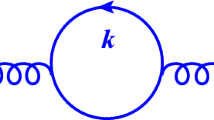Summary
Duality transformations of the type defined in electromagnetic theory are discussed and classified in terms of those having a direct relationship to an internal-symmetry structure of a given gauge theory and those that do not. It is argued that to build a satisfactory generalized electromagnetic theory with local duality invariance into a gauge theory, as at least a part of its internal-symmetry structure, requires a group structure not «smaller» thanSO 3 (orSU 2). Various reductions in aSO 3 model with sources are considered which allow one to see how the standard form of Maxwell’s theory, together with some of its immediate generalizations, may be thought of as embedded in this non-Abelian gauge theory. These reductions and this type of embedding of Maxwell’s theory are discussed in connection with spontaneous symmetry breaking. A simple type of «doubled» Weinberg-Salam model that could include a duality-invariant form of electromagnetic theory with magnetic monopoles is briefly considered.
Riassunto
Si discutono trasformazioni di dualità del tipo definito nella teoria elettromagnetica e si classificano in termini di quelle che hanno una relazione diretta con una struttura di simmetria interna di una data teoria di gauge e di quelle che non ce l’hanno. Si è arguito che per costruire una teoria elettromagnetica generalizzata soddisfacente con invarianza di dualità locale all’interno di una teoria di gauge come almeno una parte della sua struttura di simmetria interna è richiesta una struttura di gruppo non «più piccola» diSO 3 (oSU 2). Si considerano varie riduzioni in un modelloSO 3 con sorgenti che permettono di vedere come la forma standard della teoria di Maxwell, insieme con alcune delle sue generalizzazioni immediate possono essere pensate come incluse in questa teoria di gauge non Abeliana. Queste riduzioni e questo tipo d’inclusione della teoria di Maxwell sono discusse in connessione con la violazione spontanea di simmetria. Si considera brevemente un semplice tipo di modello di Weinberg-Salam «doppiato» che può includere una forma di dualità invariante della teoria elettromagnetica con monopoli magnetici.
Резюме
Обсуждаются преобразования дуальности в электромагнитной теории. Эти преобразования классифицируются на преобразования, имеющие прямую связь со структурой внутренней симметрии заданной калибровочной теории, и преобразования, которые не имеют прямой связи со структурой внутренней симметрии. Доказывается, что для построения удовлетворительной обобщенной электромагнитной теории с локальной дуальной инвариантностью в калибровочной теории, тредуется структура группы, не «меньше», чемSO 3 (илиSU 2). Рассматриваются различные упрощения в моделиSO 3 с источниками, которые позволяют понять, как стандартная форма теории Максвелла с некоторыми непосредственными обобщениями может быть внедрена в предложенную неабелеву калибровочную теорию. Обсуждаются указанные упрощения и способ внедрения теории Максвелла в связи со спонтанным нарушением симметрии. Вкратце рассматривается простой тип «двойной» модели Вейнберга-Салама, который может включать форму дуальной инвариантности электромагнитной теории с магнитными монополями.
Similar content being viewed by others
References
G. Y. Rainich:Trans. Am. Math. Soc.,27, 106 (1925);C. W. Misner andJ. A. Wheeler:Ann. Phys. (N. Y.),2, 525 (1957).
P. A. M. Dirac:Proc. R. Soc. London, Ser. A,133, 60 (1931);Phys. Rev.,74, 817 (1948). See also, for example,J. Schwinger:Phys. Rev.,144, 1087 (1966);173, 1536 (1968);Science,165, 757 (1969);F. Rohrlich:Phys. Rev.,150, 1104 (1966) as well as references cited in these papers. Throughout we use Heaviside-Lorentz units withc=1 andh=1 as needed.
S. Deser andC. Teitelboim:Phys. Rev. D,13, 1592 (1976).
G. ’t Hooft:Nucl. Phys. B,79, 276 (1974).
B. Julia andA. Zee:Phys. Rev. D,11, 2227 (1975).
See, for example,J. Schwinger:Phys. Rev. D,12, 3105 (1975).
P. B. Yasskin:Phys. Rev. D,12, 2212 (1975).
P. A. M. Dirac:Phys. Rev.,74, 817 (1948).
N. Cabibbo andE. Ferrari:Nuovo Cimento,23, 1147 (1962).
A. Trautman:Czech. J. Phys. B,29, 107 (1979).
S. Weinberg:Phys. Rev. Lett.,19, 1264 (1967);A. Salam: inElementary Particle Theory, edited byN. Svartholm (Stockholm, 1968);E. S. Abers andB. W. Lee:Phys. Rep.,9, 1 (1973).
Author information
Authors and Affiliations
Additional information
Traduzione a cura della Redazione.
Переведено редакцией.
Rights and permissions
About this article
Cite this article
Baker, W.M., Davis, W.R. On duality invariance in simple gauge theories including electromagnetic-type fields with sources. Nuov Cim A 54, 63–80 (1979). https://doi.org/10.1007/BF02902174
Received:
Published:
Issue Date:
DOI: https://doi.org/10.1007/BF02902174



